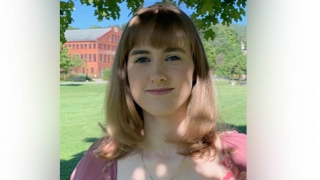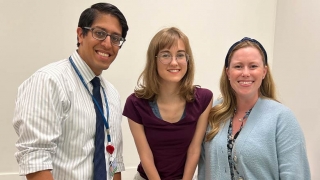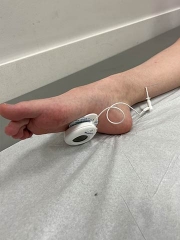Treating Bladder Dysfunction With Minimally Invasive Nerve Stimulation: Viviana’s Story
Published on
Published on
Lower urinary tract (LUT) dysfunction, also called bladder dysfunction, represents a group of conditions in which the bladder, the organ that stores pee, does not work normally. LUT dysfunction can lead to a bladder that does not fully empty or to an overactive bladder that empties too often due to the nerves around the bladder being too active. This can cause pain and feeling a near-constant need to pee. While often thought of as a disease occurring in adults, younger kids and adolescents can also struggle with LUT dysfunction. LUT dysfunction affects up to 20% of all school-aged children and adolescents and can have a negative effect on a child’s peer relationships and quality of life.
 That was the case with Viviana, a teen from central Pennsylvania. She and her mom traveled to the Urology Department at Children’s Hospital of Philadelphia (CHOP) to receive posterior tibial nerve stimulation (PTNS), a treatment commonly utilized in adults with overactive bladder, one common cause of LUT dysfunction, and only recently starting to be used in children and adolescents. In this recurring nonsurgical treatment, a needle is inserted in the foot to activate the posterior tibial nerve. While the exact mechanism of action is unknown, it is believed that this nerve stimulation helps reset the brain-bladder connections and helps relax the bladder muscles thus improving bladder control. Thanks to this minimally invasive office technique, Viviana has regained control of not only her bladder, but also her social and academic life.
That was the case with Viviana, a teen from central Pennsylvania. She and her mom traveled to the Urology Department at Children’s Hospital of Philadelphia (CHOP) to receive posterior tibial nerve stimulation (PTNS), a treatment commonly utilized in adults with overactive bladder, one common cause of LUT dysfunction, and only recently starting to be used in children and adolescents. In this recurring nonsurgical treatment, a needle is inserted in the foot to activate the posterior tibial nerve. While the exact mechanism of action is unknown, it is believed that this nerve stimulation helps reset the brain-bladder connections and helps relax the bladder muscles thus improving bladder control. Thanks to this minimally invasive office technique, Viviana has regained control of not only her bladder, but also her social and academic life.
It started in spring 2021 when Viviana was 15. “She kept telling me she had to urinate a lot,” her mom, Valerie, says. “And at first I thought, ‘Oh, she’s just drinking too much water.’ So I told her to cut back.”
This went on for several months. An ultrasound of Viviana’s kidneys and bladder was perfectly normal. But it got to the point where Viviana felt the urge to go all the time, but she could never completely empty her bladder.
“She was in extreme pain and discomfort even with only a teaspoon or two of fluid in her bladder,” Valerie says.
In fall 2021, Viviana started 10th grade. COVID restrictions had relaxed, and in-person learning had resumed. Viviana wanted the full high school experience – jazz band, drama club, the works. But the pain was so bad that it was almost impossible for her to sit through classes, much less stay after school for clubs. Teachers started to wonder if frequent trips to the bathroom were an attempt to skip out on work.
“That Christmas, we went to visit my family in New Jersey,” Valerie remembers. “We stopped at a rest stop every 10 to 15 minutes. It was 250 miles, and it took us the whole day to get there.”
 Sameer Mittal, MD, MSc; Viviana and Keely McClatchy, MSN, CPNP-PC
Valerie tried to find specialists that could help. The family waited months for appointments that gave them no solutions. Meanwhile, pain and anxiety derailed Viviana's social and school life. After-school activities, movies with friends, and even church were all too painful to endure.
Sameer Mittal, MD, MSc; Viviana and Keely McClatchy, MSN, CPNP-PC
Valerie tried to find specialists that could help. The family waited months for appointments that gave them no solutions. Meanwhile, pain and anxiety derailed Viviana's social and school life. After-school activities, movies with friends, and even church were all too painful to endure.
“I’ve had so many sleepless nights,” Valerie remembers. “I thought, what is her life going to be like? What kind of job could she get? Could she even finish high school?”
Finally, in spring of 2022, a specialist Viviana had seen suggested the family contact CHOP. After waiting months to see other doctors, Valerie was able to get Viviana an appointment with a CHOP urologist within weeks.
Jason Van Batavia, MD, MSTR, and nurse practitioner Keely McClatchy, MSN, CPNP-PC, are Viviana’s dream team. While it’s not clear what caused Viviana’s overactive bladder, Dr. Van Batavia said straight away that she would be a good candidate for PTNS.
 Viviana goes to CHOP regularly for PTNS treatments. During each appointment, a specialist inserts a needle into the nerve near her ankle. Viviana says the needle hurts a bit going in, but her mom says she’s “toughened up a lot” since treatments began. An electrode connected to the needle stimulates the nerve for 30 minutes. Viviana passes that time on her tablet or smartphone.
Viviana goes to CHOP regularly for PTNS treatments. During each appointment, a specialist inserts a needle into the nerve near her ankle. Viviana says the needle hurts a bit going in, but her mom says she’s “toughened up a lot” since treatments began. An electrode connected to the needle stimulates the nerve for 30 minutes. Viviana passes that time on her tablet or smartphone.
Viviana received the initial 12 weekly treatments five to 11 days apart. It wasn’t easy making the four-hour trip to CHOP so often, but “it was more than worth it,” says Valerie. Viviana noticed a difference in how she felt almost immediately.
Doctors don't know exactly how this electrical stimulation improves bladder function, but it’s hard to argue with the positive patient results. After Viviana’s 12 treatments, Valerie noticed “a huge difference.” A year after starting the treatments, Viviana’s problem was “90 to 95 percent” fixed, says Valerie.
The family now makes the trip to CHOP for PTNS treatments once a month.
“The drive is nothing now. We do fun things in Philly while we're there,” Valerie says. “Plus, Viviana now has her driver’s license, so she gets highway driving practice.”
Viviana is able to do fun high school activities like play trumpet in the marching band. Valerie sees how much treatment has helped, and she encourages other parents in a similar boat to give it a try.
“Don’t be put off if coming for multiple appointments in a short time seems a bit overwhelming. Because it could change your child's whole life.”